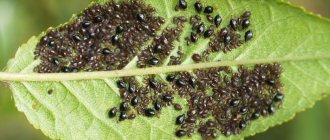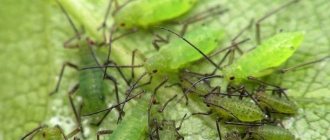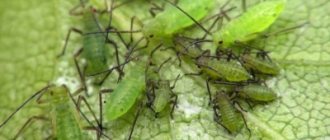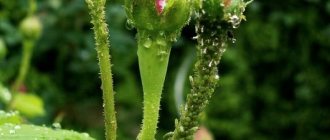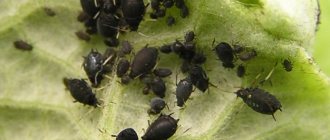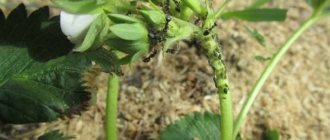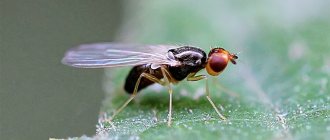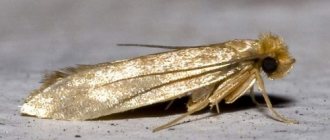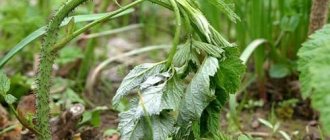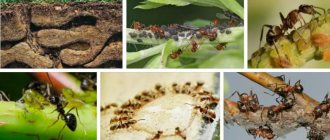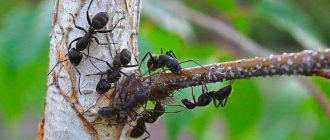How to get rid of aphids on cucumbers and how to deal with it It is necessary to know not only for beginners, but also for experienced gardeners. After all, this pest is capable of destroying the entire crop. It is necessary to combat these pests from spring in the greenhouse and from July in open ground. And this must be done quickly, since aphids reproduce in a short time and in just a week can infect all cucumber plantings, leaving the gardener without a harvest. Therefore, in this article we will talk about how to fight aphids on cucumbers folk, biological and chemical means.
What are aphids and how are they dangerous for plants, including cucumbers?
There are many types of aphids. Pumpkin crops, including cucumbers, are affected by melon aphids. Cabbage, legumes (beans, peas) and tomatoes, eggplants, and peppers also suffer from aphids.
The pest reaches no more than 2 mm in length, and it multiplies very quickly, occupying all garden beds in a matter of days.
The melon aphid damages the leaves and young shoots by piercing them and sucking the juice from the plants. As a result, the shoots stop growing, stop forming fruits, and the plant soon dies.
In addition, aphids are carriers of dangerous viral diseases, which can cause the death of neighboring crops.
The pest settles on the back side of the leaves, so it can be replaced at the wrong time.
Signs of aphids on cucumbers:
- the edges of the leaves curl down;
- deformation of the tops of the stems occurs;
- the plant stops growing;
- internodes are shortened;
- fruit formation is reduced;
- plants are covered with honeydew;
- ants appear;
- the ovaries fall off;
- the lower leaves wither;
- Small black bugs appeared on the back of the leaves.
What types of aphids attack cucumbers?
Most often, cucumbers are affected by the melon aphid, which is capable of reproducing 10 times during the summer. Its larvae absorb the sap of young plants, subsequently producing from 3 to 6 generations of wingless individuals. All subsequent generations are females capable of flight. Flying to plants, they produce another two dozen generations of parasites. In open ground conditions, the massive spread of the insect is observed from mid-July to early August, in greenhouses - a little earlier.
In addition to the melon aphid, cucumbers are also vulnerable to its other species: greenhouse (black) and potato. The first of them does not neglect any garden plants. The second one mainly eats representatives of the Solanaceae family. In most cases, these types of parasites live in greenhouses and greenhouses.
How to treat cucumbers against aphids: folk methods of fighting aphids on cucumbers
Important! To completely destroy melon aphids on cucumbers, it is necessary to carry out 2-3 treatments with an interval of 3-4 days. At the same time, various folk remedies are used so that the pest cannot adapt to them.
Treatment of cucumbers against aphids is carried out in the evening after sunset on the back side of the leaves.
Ammonia (ammonia solution)
10% ammonia effectively fights aphids.
Solution recipe:
- 10 liters of water;
- 50 ml. ammonia;
- 5 tbsp. spoons of liquid laundry soap;
- 3 tbsp. spoons of sunflower oil.
Interesting! Liquid soap enhances the adhesion of the solution to the leaves, and oil enhances the effectiveness of the product.
Mustard powder
Mustard powder is good for controlling aphids. The solution is prepared as follows:
- 100 g powder;
- 3 liters of boiling water;
- Leave for 5-6 hours (stirring occasionally);
- after the mustard settles, the liquid is poured into a 10-liter sprayer
- add 5 tbsp. spoons of liquid laundry soap;
- 3 tbsp. spoons of sunflower oil;
- 7 liters of water.
- Spraying is carried out.
Soda
Baking soda works great against aphids. Preparation of the solution:
- 10 liters of water;
- 50 g of soda (3 tablespoons);
- 5 tbsp. spoons of liquid laundry soap;
- 3 tbsp. spoons of sunflower oil.
Interesting! Soda solution is also effective against powdery mildew and rot.
Vinegar
To treat cucumbers against aphids, prepare the following solution:
- 1 tbsp. spoon of acetic acid;
- 1 liter of water;
- 1 tbsp. spoon of laundry soap or detergent.
In further recipes you need to add soap, but you can discard the oil.
Wood ash
- 200 g of ash;
- 10 liters of water;
- stand for 12 hours;
- then add 2-3 tbsp. spoons of soap, grated.
Interesting! Products based on plants that emit a pungent odor are effective: celandine, garlic, onion skins and others.
Laundry or tar soap
- Finely grate 100 g of soap;
- pour 10 liters of water.
Garlic
- 150 g crushed;
- add to 10 liters of boiling water;
- stand for 24 hours;
- filter.
Onion peel
- 200 g husk;
- 10 liters of water;
- stand for 4-5 days;
- strain.
Pine needle extract
- 1 tbsp. spoon of extract;
- 2-3 tbsp. spoons of liquid soap;
- a bucket of water.
Tobacco dust
- 2 cups of tobacco dust;
- 10 liters of water;
- Infuse for 1 day;
- filter;
- add 50 g of crushed laundry soap.
In the same way, you can prepare not an infusion, but a decoction. In this case, the mixture will need to be simmered for 30 minutes after boiling.
Tops of tomatoes and potatoes
- 3 liter jar.
- Fill it ½ full with tops.
- Boiling water is poured to the brim.
- They insist for a day.
- Rub 1 tbsp. a spoonful of laundry soap.
Celandine
Infusion of celandine is an effective remedy for aphids on cucumbers.
- 3-4 kg of freshly cut green grass or 1 kg of dry;
- 10 liters of water;
- stand for 1-2 days;
- filter;
- add 2-3 tbsp. spoons of soap (grate).
Yarrow
- 1 kg of flowers and leaves;
- fill the bucket with boiling water to the brim;
- leave for 4-5 days;
- drain the liquid into another container;
- add 2-3 tablespoons of previously crushed soap to it.
Chamomile
- 10 liters of boiling water;
- 1 kg of pharmaceutical chamomile;
- leave for 12 hours.
- dilute with water 1:3;
- rub laundry soap (40 g per 10 liters of solution).
Sorrel
- 300 g horse sorrel roots;
- 10 liters of boiling water;
- Infuse for 2 hours;
- filter and spray.
Prevention of aphids
The appearance of pests in a greenhouse can be prevented by regular treatment of the soil and structures. Prevention includes a whole range of measures.
Greenhouse disinfection
Traditionally, the greenhouse is disinfected in the fall after the end of the season. Solutions for preventive treatment of greenhouses, as well as methods for their preparation and processing are given in Table 1.
Table 1. Solutions for preventive treatment of greenhouses.
| Name, illustrations | Description how to use |
| Copper sulfate | The powder is blue or turquoise in color; when diluted, it produces a solution of copper sulfate, which kills pest larvae, as well as fungal infections. Preparation of the solution: 1 tablespoon of powder is diluted in a liter of hot water, stirred thoroughly and brought to 10 liters with cold water. Water the soil with the solution until the top five-centimeter layer is moistened, and also spray the walls of the greenhouse and the fences of the beds. |
| Bordeaux mixture | It is a mixture of quicklime and copper sulfate, used for cultivating soil and greenhouse structures. Preparation of the solution: 100 g of copper sulfate powder is diluted in a liter of hot water, brought to 5 liters with cold water. In a separate bowl, quench 120 g of lime, after which the milk of lime is diluted with water to 5 liters. Carefully pour the vitriol into the lime solution with constant stirring. The solution is used immediately. The walls and frame of the greenhouse and the top layer of soil are treated from pests and bacteria. |
| Bleaching powder | The finished powder is white in color with a sharp, specific odor. Destroys adult aphids and larvae. The powder is scattered over the surface of the soil, after which the top layer is loosened to a depth of 5-8 cm. |
| Karbofos or fufanon | A chemical substance in the form of a solution is used to treat the soil to kill pests. Dilute a solution of karbofos (30 g per 10 liters) or fufanon (10 ml per 10 liters) in cold water, water the soil until moist. |
Important! Before processing, it is necessary to completely remove all tops and plant debris from the greenhouse - pests and larvae can hide in them.
Fighting ants
Ants often settle in greenhouses; this is facilitated by early warming of the soil and stable temperature. Ants grow aphids for their sweet juice (honeydew), for which they spread them to plants. It is pointless to remove aphids without destroying anthills - ants will quickly populate new larvae in place of destroyed insects.
Ants are fought using special means or traditional methods.
- The Anteater product is used to kill ants in the form of a solution that is used to water anthills. A 1 ml bottle of the drug is diluted in 3-5 liters of water and watered anthills in the morning or evening, when the ants are in the shelter. Within 2-3 days, the entire population of the anthill dies.
Ant-eater
Prices for the product "Aardeater"
anteater remedy
- The product “Grom-2” in the form of granules is scattered over the surface of the anthill, having first removed the top layer of it by 2-3 cm. The removed soil is scattered on top of the preparation. Within 2-4 days the ants die, the effect of the product lasts up to 2 months.
- Sprinkle anthills with ash, lime or baking soda, followed by watering with hot water. Penetrating into the passages, water with an alkaline reaction has a destructive effect on ant larvae and adults.
- Digging anthills to a depth of 25-35 cm allows you to completely destroy the nest. It is performed before planting cucumbers in the greenhouse and preparing the beds. Larvae and ants are scalded with boiling water when digging.
- Plants with a pungent odor are laid out on the beds - garlic, mint, oregano, valerian. They scare away the ants and force them to leave the greenhouse.
Valerian
Oregano
Mint Garlic
Grom-2
The found anthill should be covered with ash, lime or ash.
Digging up an anthill
Important! When fighting ants, it is necessary to treat not only the soil inside the greenhouse, but also the areas adjacent to it.
Preventative treatments
To prevent the appearance of aphids, you can treat young plants with one of the biological products, for example, Fitoverm. This product does not have a harmful effect on plants or soil bacteria, and its waiting period is 2 days, after which its fruits can be eaten. Fitoverm can be used to treat plants in any phase of growth and fruiting.
Fitoverm
Dilute the drug in a dosage of 1 ampoule per 1.2 liters of water and spray the plants in the morning or evening until the leaves are moistened. Spraying for preventive purposes is sufficient to carry out once every 15-20 days, starting from planting until mid-July. During the summer period, 3 treatments are usually carried out.
Important! Fitoverm cannot be mixed with other drugs! Treatment must be carried out no earlier than 24 hours after foliar feeding and treatment with other means.
Prices for Fitoverm
fitoverm
Biological agents
If aphids have already infected many cucumber plantings, then it is necessary to resort to treatment with special fungicides: biological and chemical. Effective biological preparations for controlling aphids on cucumbers include the following:
- Bitoxibacillin;
- Aktofit;
- Biotlin;
- Fitoverm.
Fitoverm allows you to destroy pests very quickly: 2 hours after treatment they stop feeding, and after 2 days they die.
You can also use “Healthy Garden” against aphids, the main thing is to double the dosage - 4 granules per 1 liter of water). It lasts for 2-3 weeks, after which you can spray it again.
Moreover, already 3-5 days after processing, the fruits can be used for food again.
Video
This type of insect reproduces very quickly. One female produces up to 50 larvae. And after 2 weeks, having reached a certain age, they also produce new offspring. Therefore, in a short time, a colony of insects can destroy cucumbers.
It is necessary to take urgent measures aimed at their destruction. Watch the video showing available folk remedies.
The described biological infusions and remedies are also effective against spider mites, which are common pests of pumpkin crops in the middle zone.
To prevent the spread of sucking insects on plants, it is necessary to comply with preventive requirements. Avoid densely planted beds. Weed weeds regularly and feed plants with fertilizers.
The appearance of aphids on cucumbers in a greenhouse brings a lot of trouble. If uninvited insects are detected in a timely manner, it is quite possible to get rid of them. Try folk remedies to combat them, and you will find the optimal solution for yourself.
Happy cucumber harvest to you every summer!
Chemicals
Most often, after several treatments of cucumbers with folk or biological remedies, the aphids disappear. However, it happens that the pest remains. Then it is necessary to use chemical insecticides: systemic or surface.
| Name | Consumption rates, 10 l of water | After treatment, wait days before harvesting | Peculiarities |
| Inta-vir | 1 tab | 3 | do not use during flowering, toxic to bees |
| Aktellik | 3-15 ml | 20 | |
| Karbofos | 10 ml | 20 | |
| Spark Bio | 77 ml | 2 | |
| Iskra M | 10 ml | 20 | |
| Iskra Golden | 5 ml | 3 | |
| Fufanon | 10 ml | 20 | |
| Fufanon-Nova | 13 ml | 2 | |
| Commander | 5 ml | 3 |
The disadvantage of using chemicals is the long wait time for the substance to be removed. That is, the fruits can be eaten only 3-4 weeks after processing. Before this, the fruits will need to be picked and thrown away.
Preventive measures
Some simple steps will help protect cucumber plantings from aphid attacks. Secrets against aphids :
- Proper care and growing technology. It is important to monitor the balance of water and light, ventilate the greenhouse or greenhouse, and fertilize moderately.
- Along the perimeter of the garden bed or greenhouse, you can plant plants that will repel aphids with their scent. These are garlic, onions, chamomile flowers, calendula or marigolds.
- To prevent the appearance of aphids in the greenhouse, you need to replace the soil in the fall.
Replacement soil will be suitable from those areas of the garden where cucumbers and melons have not previously grown. - Before planting, check the greenhouse (greenhouse) for the presence of ant nests and, if necessary, destroy them.
- Treat all wooden elements inside the structure with lime. Wash the glass of the greenhouse thoroughly with a solution of copper sulfate.
So, an aphid infestation is a dangerous, but solvable problem. The pest can and should be fought. The effectiveness of aphid control depends on an integrated approach . Preventive measures and effective means of protection will lead to the desired result.
Advice from expert gardeners on preventive measures
Experienced gardeners recommend the following to prevent aphids on cucumbers:
- Regularly inspect the back of the leaves.
- If there are any signs of infection, treat with folk remedies.
- If traditional methods do not produce results, use biological and chemical agents.
- Regularly apply potassium-phosphorus fertilizers.
- At the same time, you need to fight the ants.
- Remove weeds in a timely manner.
- Immediately remove and burn the affected parts of the plant.
- Wash the bushes before flowering by sprinkling.
- Varieties that are resistant to insects are grown.
- Protect ventilation openings in greenhouses with mesh or gauze.
- Cover the cucumbers with a thin cloth in the open ground.
- Treat seeds and soil before sowing.
- In the fall, disinfect the greenhouse with sulfur bombs.
- Change spraying preparations so that the pest does not adapt to them.
- Do not thicken the plantings.
Using various means and preparations to combat aphids on cucumbers, you can choose the optimal ones that will allow you to get rid of the malicious pest and save your crop.
Watch the video! Aphids on cucumbers: the best ways to fight them
Harm
The usual time for an aphid attack is the second half of summer, since the pest begins active reproduction in July. Located in colonies on the underside of cucumber leaves, melon aphids feed on sap (you can find out more about what aphids feed in nature here).
The bushes begin to lose strength, the leaves turn yellow and curl, and the growth of cucumbers slows down. Black aphids cause no less harm to cucumbers. The voracious family attacks almost all parts of the plant :
- stem;
- foliage;
- inflorescences;
- ripening fruits.
A young plant attacked by a colony of aphids is unable to develop and produce an ovary. Most of the cucumbers die.
Cucumbers suffer from aphid invasion not only in the open ground, but also in the greenhouse. The sugary juice (honeydew) secreted by insects glues cucumber leaves together and is a good bait for other garden pests.
Description of the pest
It’s worth clarifying right away that there is no separate family called “black aphid.” This is what people call aphid species with black, dark blue and green-brown colors. The pest is a tiny insect, not exceeding 5 mm in size.
Did you know? Insects appeared on Earth much earlier than other animals - approximately 400 million years before the present day. The endurance of these small creatures is so high that they are able to survive any disaster. Even if humanity exterminates itself, it is unlikely that it will be able to completely destroy insects.
To procreate, the female black aphid does not require the reproductive cells of a male individual, so these parasites reproduce at high speed. The female lays eggs on the food vegetation itself, where they can safely overwinter.
The life cycle of aphids is very short - after reaching maturity, the individual lives only 2 weeks. During this short period, the female is able to lay up to 150 eggs. The larvae begin to parasitize immediately after hatching.
Aphids usually settle on the bottom of leaves, where they feed on the juice of young cucumber leaves and shoots rich in carbohydrates and individual amino acids. The insect is endowed with a special proboscis, with the help of which it can suck juice from fairly thick plant skins.
Determining the presence of aphids is not difficult. Small pests can be found on leaves, flowers, ovaries and shoots of garden crops. Often, aphids first attack the weeds around the garden, then the aphids successfully move onto vegetables.
We recommend reading
How to grow cucumbers correctly The threat of black aphids lies in the high density of their accumulation on the bush. Due to lack of food, they have to fly from bush to bush. A mass of individuals attack a leaf plate or other part of the plant, pierce its surface and allow bacteria access there.
When infected with fungal spores, the plant begins to rot rapidly. Aphids drain all their strength from the tissues of seedlings; as a result, the garden crop dies before it has time to bear fruit.
Symptoms of the lesion
At the initial stage of infection, it is difficult to see small bugs merging with the greenery. But as the aphids spread in the area, the first symptoms appear:
- plants are delayed in growth and development;
- flowering begins much later than expected;
- the upper leaves first wither, then dry and curl;
- droplets of liquid appear on the leaves - honey dew;
- a large number of ants appear on the site;
- the ovaries dry out and fall off;
- the lower leaves fade;
- the reverse side of the leaves seems to be covered with green or black bugs.
The photo shows cucumber leaves infected with aphids.

